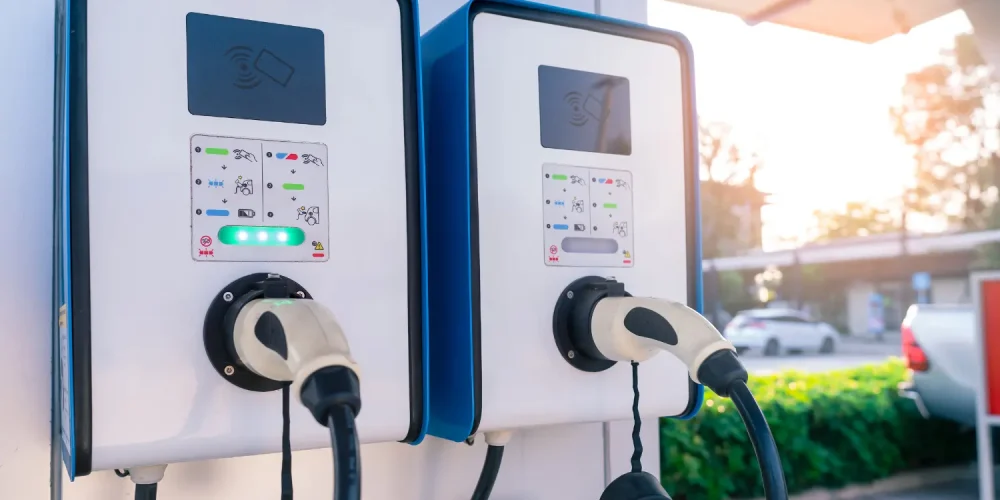
Electric Vehicle Supply Equipment, or EVSE, is the technical term for what most people recognize as an EV charger. It refers to the hardware and software that safely transfer electricity from the grid to an electric car’s battery. This includes the connectors, cables, communication systems, and other components that make the process safe and efficient.
Most of us see EV charging as a car plugged into a wall-mounted box at home or a public station by the roadside — quite like charging a smartphone, only at a much larger scale. Yet the reality is more layered. EVSE comes in several forms, with different power levels, standards, and protocols designed for various use cases.
So, while it’s okay to call EVSE a charger, the term however covers a much broader system. It’s a link between the grid and the vehicle that keeps everything running safely and reliably.
In this article, we’ll break it all down. So without further ado, let’s get into it…
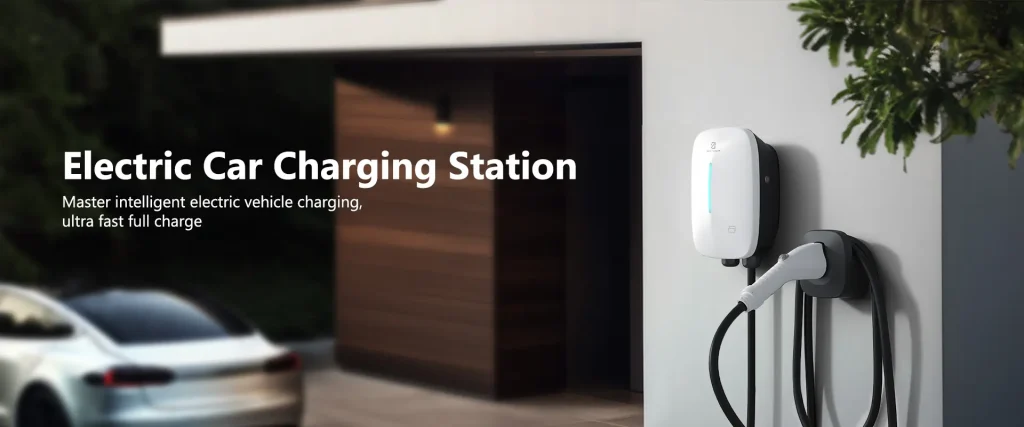
1. The EVSE Build, Structure, and Core Components
Every EV charger, whether it’s a compact home unit or a high-power public station, follows the same basic anatomy. Each part plays a role in ensuring safe, reliable, and efficient energy transfer to the vehicle.
At a glance, an EVSE typically includes:
- Housing or enclosure
- Internal electronics
- Firmware
- Network connectivity (optional)
- Power connection
- Charging port(s) & cable(s)
- Connectors that plug into the EV
We’ll look at each of these in detail next to understand how they come together to make EV charging possible.
1.1 Housing or enclosure
The housing is the visible body of an EVSE — the part that holds everything together and protects the internal components. Its design varies depending on where and how it’s used.
- The simplest form, often called a box-on-a-cable, is common for home setups.
- Wall- and pedestal-mounted units suit homes, workplaces, and public areas, offering flexibility in installation.
- Then there are tall tower-type enclosures typically found at fleet depots and high-traffic charging sites.
Each form factor is built for its environment, balancing durability, accessibility, and safety.
1.2 Electronics (Inside Housing)
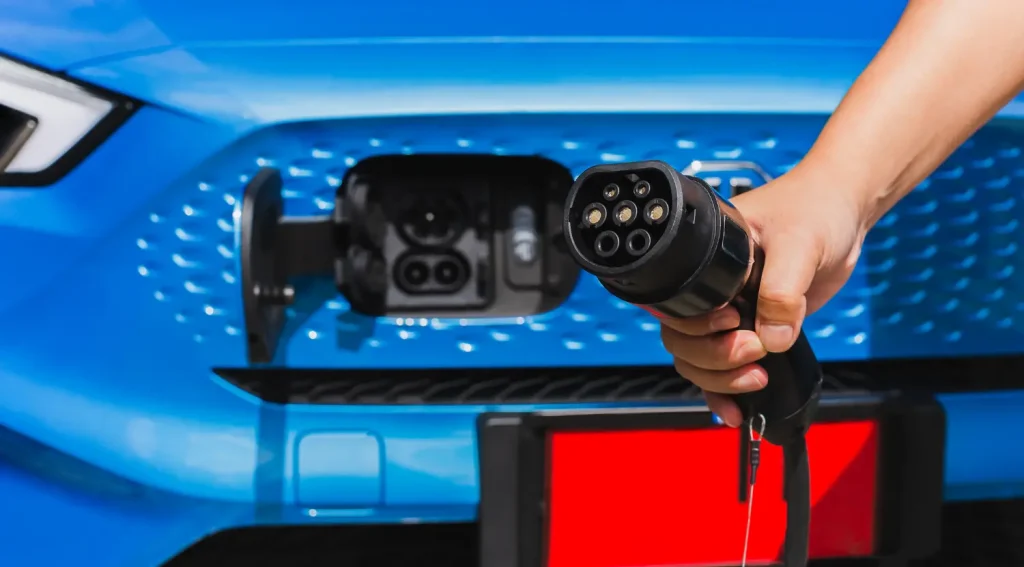
Inside the housing lies the main system that manages and controls the flow of electricity to the vehicle.
- The main relay switches the power on or off as needed.
- The control module manages the relay and oversees the entire charging session, including start and stop functions.
- The power supply provides energy to both the control module and the relay.
- Each charging socket or fixed cable attachment has its own electrical circuit to regulate power flow.
Some units also include a user interface, such as an LCD screen like Duevolt’s Portable EV Charger to display charging details and status.
1.3 Firmware
Firmware is the built-in software that allows the EVSE’s hardware components to operate correctly and communicate with the vehicle. It resides in the device’s read-only memory and ensures smooth coordination between all systems.
- It starts and stops charging sessions as commanded.
- It ensures electrical safety throughout the process.
- It provides cybersecurity protection against potential threats.
- It communicates with the vehicle to check battery condition, state of charge, and required power.
Firmware can be updated to add new features or improve compatibility with different EV brands and models.
1.4 Power Connection
EVSE units draw electricity from different power sources depending on their setup and location.
- Level 1 charging uses standard 120-volt household outlets, most often for basic residential charging.
- Level 2 chargers operate on 208- to 240-volt AC outlets and are common in homes, workplaces, hotels, and fleet facilities. These units may be hardwired directly into a 240V household or 208V commercial service.
- Multi-charger installations, whether private or public, are typically hardwired into dedicated electrical infrastructure connected directly to the grid.
Each setup ensures safe and consistent power delivery suited to the site’s needs.
Related: The Difference Between Level 1 And Level 2 EV Chargers
1.5 Network Connectivity
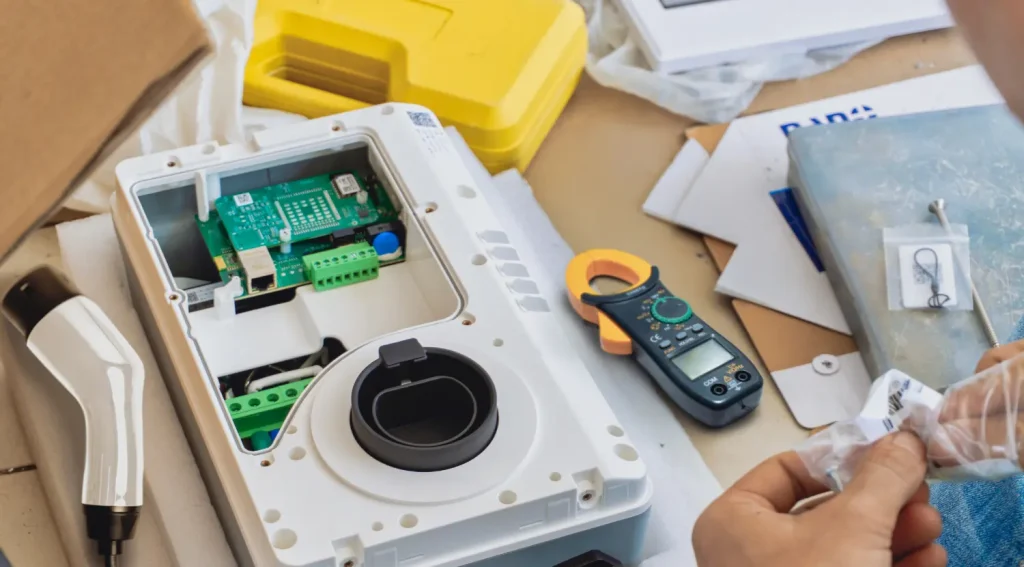
Smart chargers include built-in connectivity features that link the EVSE to apps and cloud-based management systems. Most connect through Wi-Fi or cellular networks, enabling communication between the charger, the vehicle, and external platforms.
- It allows EV owners to start, stop, and schedule charging remotely.
- It helps take advantage of time-of-use tariffs to lower charging costs.
- It enables real-time monitoring and management of charging activity.
These features make these chargers more efficient and user-friendly, offering flexibility that traditional standalone units lack.
1.6 Ports & Cables
Ports are the connection points on the EVSE housing where charging cables attach. In some units, the cables are permanently fixed, while in others they connect through detachable ports.
The cables act as flexible conduits that carry electricity from the EVSE to the vehicle, ensuring a safe and steady transfer of power. Their design allows for flexibility, durability, and ease of use in different charging environments.
1.7 Connectors

Connectors sit at the end of the charging cable and plug into the vehicle’s charging port. The type of connector used depends on several factors, such as the charger level, whether it supplies AC or DC power, the standards supported by the EVSE provider, and regional requirements.
Common configurations include:
- Level 1 charging uses 120-volt AC with either no connector or the J1772 type, suited mainly for home use.
- Level 2 charging operates on 208- to 240-volt AC and typically uses J1772, CCS, NACS, or CHAdeMO connectors for faster charging.
- Level 3 charging, or DC fast charging, runs on 400- to 900-volt DC and uses CCS, NACS, or CHAdeMO connectors, delivering much quicker charge times.
These connector types define compatibility across regions and ensure safe, standardized power delivery between charger and vehicle.
Also read: A Comprehensive Guide To Global EV Charger Standards
2. How Does EVSE Work?
When the charging cable is connected to the vehicle, the EVSE’s control module begins a sequence of checks before allowing electricity to flow.
It verifies that:
- The connector is properly attached to the vehicle’s charging port.
- The vehicle is ready to accept a charge.
The station itself is operating safely and without faults.
Once confirmed, indicator lights show the system’s status — usually green when charging is ready to start.
After all checks pass, the main relay activates, enabling power transfer from the grid to the vehicle.
- In AC charging, power passes through the car’s onboard charger, which converts it into DC to charge the battery.
- In DC fast charging, the conversion happens within the station itself, sending direct current straight to the battery for faster results.
When charging completes or is stopped manually, the relay disconnects, ensuring safe removal of the cable and a fully charged vehicle.
3. Common Features
EVSE units are built with multiple safety and convenience features to protect the user and the vehicle both during charging. These functions work quietly in the background to make each session efficient and reliable.
- Indicator lights show power and charging status.
- Breakaway safety cable prevents damage during accidental disconnection.
- Integrated cable storage keeps cables tidy and accessible.
- Automatic short-circuit and ground-fault shut-off protects against electrical risks.
- Ground-fault monitoring maintains safety without manual checks.-
- Power sharing balances load with other household appliances.
- Auto-restart resumes charging after a power outage.
- Regulated current ensures steady, safe power delivery.
- Safety lock-out stops current when the charger isn’t properly connected.
- Automatic disconnect shuts off power in case of faults to prevent damage or fire hazards.
Together, these features make modern EVSE systems dependable and user-safe.
At Duevolt, we’re proud to say that our EV chargers are equipped with all the convenience and safety features mentioned above. Each unit is built to meet industry standards and designed to deliver reliable performance for every charging session.
You can explore our full catalog here to find the model that best fits your needs.
4. Common Types of EVSE
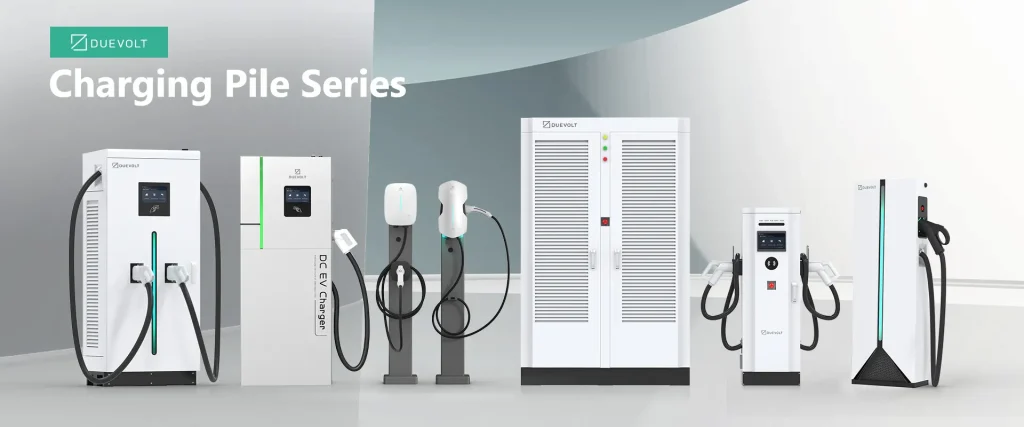
EVSE is available in different types to suit various charging needs and environments. Each type varies in speed, voltage, and application.
- Level 1 (120V) uses a standard household outlet and offers the slowest charging rate. It’s best suited for overnight home use or where extended charging time isn’t an issue.
- Level 2 (240V) operates on higher voltage, providing a faster charge and serving as the most common option for homes, workplaces, and public stations.
- DC Fast Charging (DCFC) delivers high-voltage direct current for rapid charging, primarily at commercial or highway stations. However, frequent use can contribute to long-term battery wear.
- Wireless Charging relies on inductive or resonant technology to transfer power without cables. It offers convenience by removing the need for physical connection.
Related: Best Portable EV Chargers For 2025
5. Closing Thoughts
On the whole, EVSE is far more than just a “charging box.” It’s a complete system that bridges the gap between the grid and your vehicle, ensuring every charge is safe, controlled, and efficient. As electric mobility continues to grow, understanding how this technology works could help you make smarter choices about where and how they charge.
At Duevolt, we believe reliability starts with design — and that’s exactly what our EV chargers deliver. Safe, smart, and built for everyday use.
